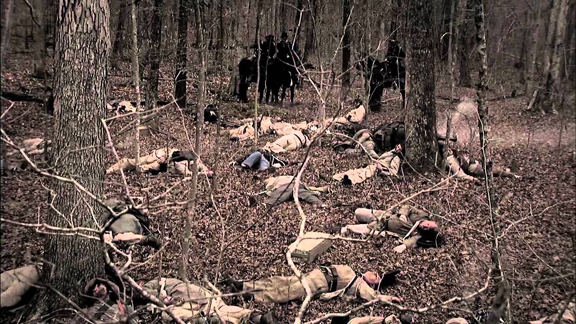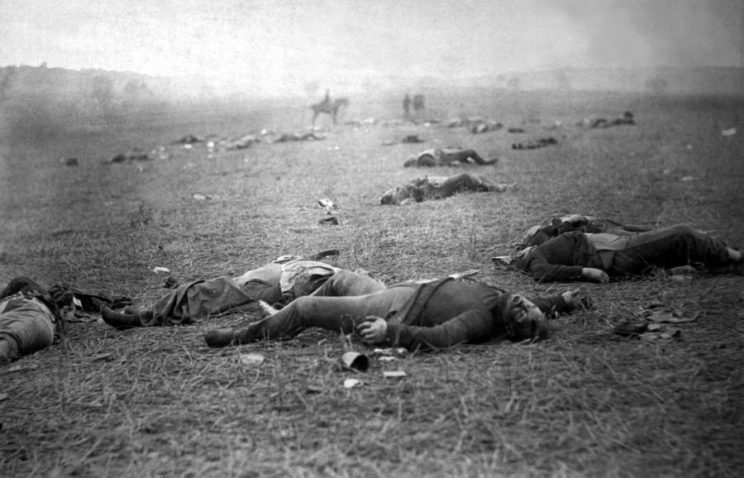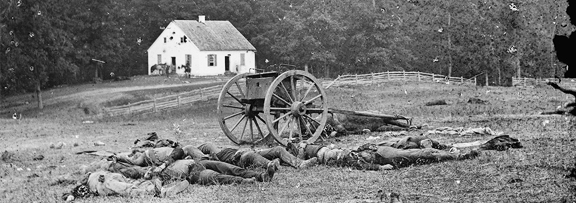Hotbeds of Hostility
by Gary Wright
“If he has a conscience, he will suffer for his mistake. That will be his punishment.”
— Fyodor Dostoevsky, Crime and Punishment

The North American continent had never seen carnage the likes of the Civil War when brother was pitted against brother; father against son; neighbor against neighbor for four horrifying years of bloodletting and terror. The battlefront was ghastly in the scope of its ferocity and destruction, and the battlefront seemed to be everywhere. All of the border states of Maryland, Kentucky, Missouri, and Kansas were rife with pillaging, looting, and murder. Most of the civilian law and order had broken down. Whichever side, North or South, which occupied a border area ruled it by military force when it could spare men from actual military operations. When no military could be spared, then rogue elements and outlaw gangs dominated by brute force, manifesting murder, mayhem, and random violence as though Hell itself were in session on earth.
There was usually little law and order in all the multi-state border areas on both sides. Border ruffians, outlaws, and brigands ruled by terror and force. So many factions pledged loyalty to one side or the other, but these loyalties were ever-shifting and changing. Many today think that there was one solid North with anti-slavery, anti-South feelings, and one massed South where everyone was solidly pro-slavery and hated the North. Nothing could have been further from the truth. The newly formed Republican Party dominated northern politics, and the election of its first presidential candidate, Abraham Lincoln, served as the immediate impetus for the outbreak of the Civil War. What remained of the Democrat Party in the North was divided into ‘War-Democrats,’ who largely supported Lincoln’s War, and the ‘Copperheads,’ the remaining northern Democrats who strongly opposed the entire war effort. The latter claimed that it was unconstitutional from the very beginning and often took to the streets in riots, protests, and armed actions against the northern government.
One was not safe even in the innermost parts of both the North and the South if you thought differently from the faction in power. In the North, pockets of resistance often resulted in bloodshed against Northern policies and actions. Coal miners in West Virginia attacked authorities when they came to draft fellow coal miners into the Union Army. The great draft riot on New York City occurred in July 1863. Initially, it was a riot against compulsory draft into the Union Army but quickly turned into a race riot. Somewhere around 500 people were killed in four days of turmoil and agitation. Between July 1863 and July 1865, over 750,000 men were drafted into the Union Army, and less than 50,000 showed up voluntarily.
Initial support for ‘Lincoln’s War’ shifted dramatically after his ‘Emancipation Proclamation’ exploded on the scene. Public perception shifted from a war to hold together the Union to a nobler concept of freeing enslaved souls and fighting a holy war against the minions of Satan. Pockets of protest, riots, and outright resistance erupted throughout the North at various times during the war. Appalachia was especially hard hit as its citizens segmented into groups who fought the officials, the North, the South, and each other, and caused a general sense of insecurity which heightened the already terrible economic and security concerns.
Another hotbed was in Pennsylvania where disunity, protests, and riots reached such a level that in 1864, the Union Army was dispatched to quell disorder, arrest dissidents, and to restore order. These insurrections and uprisings, in large part, weighed heavily on the mind of General Robert E. Lee and aided his thought process in his momentous decision to invade the North and to meet his fate at Gettysburg.

The South was not without its own protests and dis-loyalties. Dissident movements erupted at various times during the war in Winston County, Alabama, where the inhabitants voted overwhelmingly to secede from the Confederacy if the Confederacy seceded from the Union. It did, and they did. Jones County, Mississippi, at varying times, was under the control of Southerners who tried to secede from the Confederacy. This Union strong-hold in the middle of the South fought over 14 skirmishes with Confederate military forces. The 6th Mississippi Regulars were sent against the Jones loyalists and crushed them. However, when the regulars left the County, the loyalists sprang up again.
Some 96% of Scott County, Tennessee residents voted to secede from the state when Tennessee seceded from the Union in 1861. They formed the Free and Independent State of Scott, and that proclamation was not withdrawn for over a hundred years, finally being repealed in 1986. Searcy County, Arkansas, was the scene of bloody infighting as many of its inhabitants were loyal to the Union. That County was placed under Confederate military rule for a while during the Civil War, and many of its insurrectionists were arrested and forcibly removed. Most were given clemency if they would recant their loyalty and join the Confederate military. Most did and subsequently deserted.
The German immigrants of the Texas Hill Country around San Antonio had no wish to fight in the War or to support either side. Many had recently emigrated from war-torn Europe, where war had been a way of life for generations. They simply wished to be left alone. In August 1862, some 65 of these pacifists attempted to leave Texas for Union-held New Orleans. En route, they were ambushed by a force of Confederate cavalrymen. Nineteen Germans were killed in the initial attack, and several others were later executed as traitors to the Southern cause.

It is easy to suppose that the American Civil War was a conflict between the North and the South to preserve the Union and make the continent safe for democracy. It was not that simple, as such things are never quite that crisp and clear. Of course, the War was about slavery, along with a hundred other cultural, economic, social, and democratic issues. The feelings of the population from all points of the North and South were as complicated as the reasons for the war itself. Factions fought factions; families fought themselves, politics often exploded into death struggles. It was a time of pent-up anger finally boiling over as old scores were settled.
There was little cohesion and less order, as communities turned on each other, then back again, only to find new or previously hidden enemies with whom to struggle. All through the North and South lurked hidden anger, which erupted at the slightest provocation in animosity, aggression, and death. It was a time when passion quickly turned to murder in these hotbeds of hostility. When the rule of law and common decency break down, something evil, always lurking, barely hidden, in the hearts of humankind will rear its ugly head and will ever reign until goodness once again conquers the heart of darkness. It is for us to be ever watchful and to recognize evil whenever it begins. We must act quickly, lawfully, and correctly to maintain that balance of the use of force and good government. We must never settle for the ‘lesser of two evils,’ for that is still evil.
Civil War Images from Google Images


